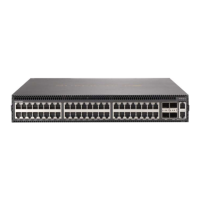SSE-X3348T/ SSE-X3348TR Switch Installation Manual
5-6
1000BASE-T Pin Assignments
All 1000BASE-T ports support automatic MDI/MDI-X operation, so you can use
straight-through cables for all network connections to PCs, servers, or switches.
The table below shows the 1000BASE-T MDI and MDI-X port pinouts. These ports
require that all four pairs of wires be connected. Note that for 1000BASE-T operation, all
four pairs of wires are used for both transmit and receive.
1000BASE-T Cable Requirements
All Category 5 UTP cables that are used for 100BASE-TX connections should also work
for 1000BASE-T, providing that all four wire pairs are connected. However, it is
recommended that for all critical connections, or any new cable installations, Category
5e (enhanced Category 5) or Category 6 cable should be used. The Category 5e and 6
specifications include test parameters that are only recommendations for Category 5.
Therefore, the first step in preparing existing Category 5 cabling for running
1000BASE-T is a simple test of the cable installation to be sure that it complies with the
IEEE 802.3-2008 standards.
10GBASE-T Cable Requirements
Use 100-ohm Category 5e, 6, 6a or 7 twisted-pair cable for 10GBASE-T connections as
specified in Table 5-2. Also be sure that the length of any twisted-pair connection does
not exceed the lengths specified in this table.
The primary cable specified for 10GBASE-T is augmented Category 6 (Category 6a).
Other types also work, but the specific installation may have to be qualified for 10G
operation. See the IEEE 802.3an-2006 standard and the relevant TIA specifications
listed therein.
Installed Category 6 cabling must pass tests specified in the ANSI/TIA-TSB-155 and
ISO/IEC 24750 standards. Category 6a cables must also pass test parameters specified
in the ANSI/TIA/EIA-568-B.2-10 standard. Methods of mitigating of alien crosstalk in
Category 6 and 6a cable is covered in ANSI/TIATSB-155 and ISO/IEC TR24750.
Table 5-4. 1000BASE-T MDI and MDI-X Port Pinouts
Pin MDI Signal Name MDI-X Signal Name
1 Bi-directional Pair A Plus (BI_DA+) Bi-directional Pair B Plus (BI_DB+)
2 Bi-directional Pair A Minus (BI_DA-) Bi-directional Pair B Minus (BI_DB-)
3 Bi-directional Pair B Plus (BI_DB+) Bi-directional Pair A Plus (BI_DA+)
4 Bi-directional Pair C Plus (BI_DC+) Bi-directional Pair D Plus (BI_DD+)
5 Bi-directional Pair C Minus (BI_DC-) Bi-directional Pair D Minus (BI_DD-)
6 Bi-directional Pair B Minus (BI_DB-) Bi-directional Pair A Minus (BI_DA-)
7 Bi-directional Pair D Plus (BI_DD+) Bi-directional Pair C Plus (BI_DC+)
8 Bi-directional Pair D Minus (BI_DD-) Bi-directional Pair C Minus (BI_DC-)

